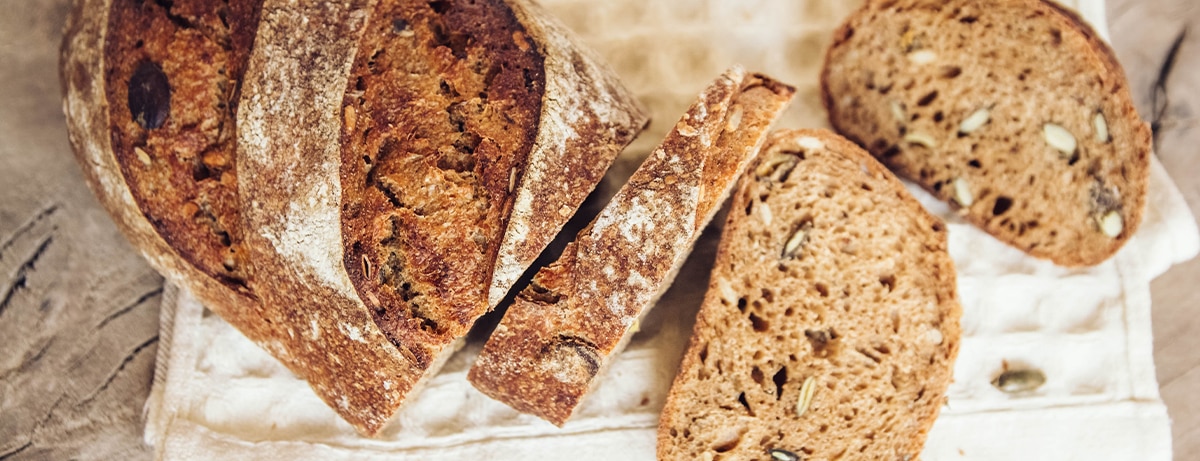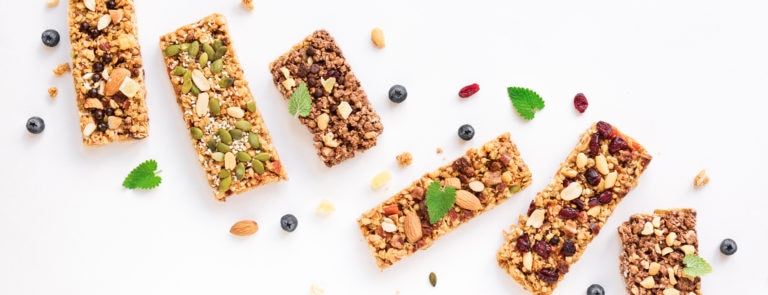15% off €30 or 20% off €40
Foods to avoid if you have a gluten intolerance

Summary
1Which foods contain gluten?
A lot of foods are naturally gluten-free when you get them raw and unprocessed, e.g. meat, fish, vegetables, legumes, pulses, rice and other grains...
2Grains, seeds, cereals, legumes & starchy plants
Does rice contain gluten? Is barley gluten-free? Filling and full of fibre and nutrients, grains are a staple in any healthy diet...
3Popular supermarket products
When it comes to pre-made bread, snacks, desserts, sauces and all the other bits you get from the supermarket, likely a lot of them will contain...
Navigating the food world with coeliac disease or a gluten intolerance can be a minefield! Who’d have known so many of the favourite foods we enjoy on the daily contain gluten?
Not to worry though, there are lots of naturally gluten-free foods and equally tasty alternatives available nowadays, sometimes it’s just about knowing what to look for.
Keep reading for a list of foods to avoid as well as the foods you can replace them with, so you can live life feeling good, without missing out.
What is gluten?
Gluten is the name given to two proteins, glutenin and gliadin that are found in wheat, rye, oats, and barley or any products tehreof.1 You can develop a sensitivity (a gluten intolerance) or have an adverse reaction to it (coeliac disease).
What is coeliac disease?
What is a gluten intolerance?
Gluten intolerance or non-coeliac gluten sensitivity (NCGS) happens when your body can’t digest gluten4. This condition shows itself through a variety of symptoms, including bloating, abdominal pain, gas, diarrhoea, constipation, and headaches5. It is recommended that you at least cut down or completely eliminate gluten from your diet if you have this condition.
Which foods contain gluten?
A lot of foods are naturally gluten-free when you get them raw and unprocessed, e.g., meat, fish, vegetables, legumes, pulses, rice and other grains.6

Flour
Going down the bakery isle can be nightmare when you’re avoiding gluten. How are you supposed to make a cake for your gluten-free guest at your dinner party? Is freshly baked bread out of the question? No and no! Find out the ingredients you need to avoid, and which gluten-free alternative is best for your needs- Wheat flour (all purpose, self-raising, etc. most flours you come across will be wheat-based)
- Whole wheat flour
- Spelt flour
- Rye flour (low gluten but not gluten free)
- Durum flour7
Almond flour:
- Great for - Baking cookies, cakes and quick breads.
- Top tip - Try using it to bake up a batch of dainty macarons.
Buckwheat flour:
- Great for - Pancakes, waffles and crepes. Dense quick breads, cakes and soba noodles.
- Top tip - Use 1:1 with rice flour if the flavour is too overpowering.
Brown rice flour:
- Great for - Rice noodles, pancakes, biscuits and cakes.
- Top tip - Use it to thicken up sauces and soups.
Coconut flour:
- Great for - Cakes, cookies, bread and muffins.
- Top tip - Make sure you add extra liquid. It’s great for keto and paleo diets!
Gram flour (chickpea):
- Great for - Pakoras, onion bhajis, flatbreads, savoury pancakes and falafel.
- Top tip - Mix with water 1:1 for a great vegan egg replacement. You can also use it to make gluten free Yorkshire puddings!
Potato flour / tapioca flour:
- Great for - Bread and flatbreads.
- Top tip - Use it to thicken sauces and stews – especially if they’re potato based.
Maize / cornflour:
- Great for - Breading for fish / veg / meat. Pancakes, bread, muffins and cakes.
- Top tip - Try using it to make delicious cornbread.
Other gluten-free flours: oat flour, millet flour, quinoa flour, flaxseed meal, amaranth flour, chestnut flour, and hemp flour.8 You can also get specially-made gluten-free flour for specific tasks, e.g. gluten-free bread flour, gluten-free self-raising flour, etc.
Always check packaging labels as some products may contain gluten and some may have cross-contamination warnings, for example they were made in a factory that also handles products containing gluten.
Grains, seeds, cereals, legumes & starchy plants (your side dishes)
Does rice contain gluten? Is barley gluten-free? Filling and full of fibre and nutrients, grains are a staple in any healthy diet, however, quite a few contain gluten.9
Here’s a low down on the most common grains containing gluten and how we can replace them.
- Barley
- Bulgar wheat
- Couscous
- Durum wheat
- Einkorn
- Elmer (faro)
- Khorasan wheat (kamut)
- Pearl barley
- Rye
- Semolina
- Spelt
- Triticale (wheat / rye hybrid)
- Wheat9
Here are some of the most popular gluten-free grains, pulses, seeds, and starchy vegetables and how to use them:
Buckwheat:
- Common uses: Salad topping think of it as a healthy crouton! And baking (see flour above).
- Top tip: Toast before eating.
Cassava (manioc)
- Common uses: Roasted, fried, baked; this nutty starch like a potato.
- Top tip: Raw cassava contains cyanide, so you need to prepare it correctly.
Flaxseed (linseed)
- Common uses: Sprinkled on cereals and salads or mix it into soups to thicken.
- Top tip: Add it to doughs, casseroles and batters, too.
Quinoa
- Common uses: High-protein side treat it like rice. Great for salads.
- Top tip: Rinse under cold running water to remove bitterness.
Rice
- Common uses: We’re sure you know how to use rice!
- Top tip: Choose brown rice for more fibre and protein.
Pulses
- Common uses: Chickpeas, lentils, beans and peas make tasty curries, casseroles, stews, chillies, etc.
- Top tip: If you like curry, try a lentil dahl or chickpea curry.
Potato
- Common uses: You’ll be glad to know potatoes are gluten free too!
- Top tip: Maris Piper potatoes make the best roasties.
Polenta
- Common uses: Hot porridge that can be cooled and solidified into a loaf and baked, fried or grilled.
- Top tip: Add water when cooking if its gritty.
Millet
- Common uses: Not just for birds! Use it like couscous / quinoa.
- Top tip: Toasting before adding liquid enhances its nutty flavour.
Other gluten-free grains: agar, almond, amaranth, carrageenan, chestnut, corn, gram flour, hemp, hops, maize, millet, mustard, potato, sage, sesame, soya, tapioca, teff and urad flour.9
Are oats gluten-free? Oats don’t naturally contain gluten, but the way they are produced means sometimes they are not10. Make sure to check the label – like with anything if you are avoiding gluten.
Other fresh fruit and veg are definitely still on the table – as long as it hasn’t been processed with ingredients containing gluten.11 Check the label of frozen fruits and smoothies just to be on the safe side.
Again, always check the packaging label as some products may contain gluten and some may have cross-contamination warnings, like if they were made in a factory that also handles products containing gluten.
Popular supermarket products
When it comes to pre-made bread, snacks, desserts, sauces and all the other bits you get from the supermarket, it’s likely a lot of them will contain gluten in some way. Wheat is a very popular ingredient it seems! Then comes the issue of cross-contamination…
Here’s a quick guide to the cupboard staples that usually contain wheat and their alternatives, so you can still enjoy your favourite gluten-free snacks.
| Common uses | Top tip | |
| Bread | Pizza bases, rolls and loaves often contain wheat. | Check the free-from section in your local supermarket for gluten free pizza bases or loaves. (or have a go at making your own) – The Box Bakery can help you out there! |
| Desserts | Pretty much any dessert can be made gluten free, especially ones like mousses, cheesecakes, ice cream, etc. that don’t rely so heavily on wheat. Try making your own! | Search for flourless dessert or dairy / plant milk-based dessert recipes or check out your supermarket’s free from section. |
| Crips | Potatoes are gluten free, so crisps should be, right? Wrong, a lot of our favourite crisps use wheat flour to coat the crisps or barley malt extract as a flavouring – always check the label. | Eat Real crisps are a great choice if you’re cutting out gluten. The whole range is made from ingredients like chickpeas, quinoa and lentils and they’re all gluten free and delicious! |
| Breakfast cereal | Wheat is a popular ingredient in breakfast cereals, as well as barley malt extract for flavouring. Even if you opt for rice and corn-based cereals. | Gluten-free oats should be quite easy to find in your local supermarket. But if you want an alternative to your old favourites, head to the free from isle or check out our range of gluten-free breakfast cereals. |
| Condiments / Sauces / Spices | Many of these products contain gluten ingredients – even single spices can have a cross-contamination risk, so always check the label. | French’s yellow mustard and Heinz ketchup are considered gluten free.
Always check soy sauce labels as the fermentation process usually involves wheat. Try this Tamari Soy Sauce if you want a gluten free soy sauce. |
| Pasta | Just like bread, pasta is normally full of gluten as it is made of durum wheat. | You can get pasta made of vegetables like edamame and spinach which are usually gluten free and nutritious! |
| Biscuits / Cake | Unfortunately, a lot of baked goods like biscuits and cakes you can pick up at the supermarket will contain gluten. Wheat flour is cheap and easy to use, and let’s not even get on to the flavourings, etc, that get added! | Gluten-free cakes and goodies are only becoming more and more popular. Check your local supermarket’s free from section, or take a browse of ours for teats like gluten-free Jammy Wheels or gluten free bakes. You can also get creative and use the alternative flour info above to make your own delicious treats! |
The final say
While there are so many foods out there that contain gluten, the number of gluten-free alternative products on the market is growing, so there is much more freedom than you might think!
From gluten-free snacks like crisps and cakes to other gluten-free foods like pasta and bread, you don’t have to miss out on your favourite foods just because you can’t eat gluten.
However, please always check every label for wheat and gluten and watch out for cross-contamination issues if you have to be that strict.
1. https://celiac.org/gluten-free-living/what-is-gluten/
2. https://www.nhs.uk/conditions/coeliac-disease/
3. https://www.nhs.uk/conditions/coeliac-disease/symptoms/
5. https://www.ncbi.nlm.nih.gov/pmc/articles/PMC4406911/
6. https://www.nhs.uk/conditions/coeliac-disease/treatment/
7. https://celiac.org/gluten-free-living/what-is-gluten/sources-of-gluten/
8. https://www.beyondceliac.org/gluten-free-diet/baking/intro-to-flour/



